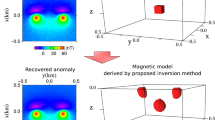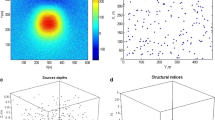Abstract
This paper presents a new inversion method for the interpretation of 2D magnetic anomaly data, which uses the combination of the analytic signal and its total gradient to estimate the depth and the nature (structural index) of an isolated magnetic source. However, our proposed method is sensitive to noise. In order to lower the effect of noise, we apply upward continuation technique to smooth the anomaly. Tests on synthetic noise-free and noise corrupted magnetic data show that the new method can successfully estimate the depth and the nature of the causative source. The practical application of the technique is applied to measured magnetic anomaly data from Jurh area, northeast China, and the inversion results are in agreement with the inversion results from Euler deconvolution of the analytic signal.





Similar content being viewed by others
References
Atchuta, R. D., Ram-Badu, H.V. and Sanker-Narayan, P.V. (1981), Interpretation of magnetic anomalies due to dikes: The complex gradient method, Geophysics 46, 1572–1578.
Bastani, M. and Pedersen, L.B. (2001), Automatic interpretation of magnetic dike parameters using the analytic signal technique, Geophysics 66, 551–561.
Debeglia, N. and Corpel, J. (1997), Automatic 3-D interpretation of potential field data using analytic signal derivatives, Geophysics 62, 87–96.
Hsu, S.K., Coppens, D. and Shyu, C.T. (1998), Depth to magnetic source using the generalized analytic signal, Geophysics 63, 1947–1957.
Florio, G., Fedi, M. and Pasteka, R. (2006), On the application of Euler deconvolution to the analytic signal, Geophysics 71, L87-L93.
Huang, L. and Guan, Z. (1998), Discussion on “Magnetic interpretation using the 3-D analytic signal” by Walter R. Roest, Jacob Verhoef, and Mark Pilkington, Geophysics 63, 667–670.
Li X. (2006), Understanding 3D analytic signal amplitude, Geophysics 71, L13-L16.
Keating, P. and Pilkington, M. (2004), Euler deconvolution of the analytic signal and its application to magnetic interpretation, Geophysical Prospecting 52, 165–182.
Keating P. (2009), Improved use of the local wavenumber in potential-field interpretation, Geophysics 74, L75-L85.
Macleod, I.N., Jones, K. and Dai T.F. (1993), 3-D analytic signal in the interpretation of total magnetic field data at low magnetic latitudes, Exploration Geophysics 24, 679–688.
Nabighian, M.N. (1972), The analytic signal of two-dimensional magnetic bodies with polygonal cross-section: its properties and use for automated anomaly interpretation, Geophysics 37, 507–517.
Roest, W.R., Verhoef, J. and Pilkington, M. (1992), Magnetic interpretation using 3-D analytic signal, Geophysics 57, 116–125.
Salem, A. and Ravat, D. (2003), A combined analytic signal and Euler method (AN-EUL) for automatic interpretation of magnetic data, Geophysics 68, 1952–1961.
Salem, A. and Ravat, D., Mushayandebvu, M. F. and Ushijima, K. (2004), Linearized least-squares method for interpretation of potential-field data from sources of simple geometry, Geophysics 69, 783–788.
Salem, A. (2005), Interpretation of magnetic data using analytic signal derivatives, Geophysical Prospecting 53, 75–82.
Wen, B.D., Hsu, S. K. and Yeh, Y. C. (2007). A derivative-based interpretation approach to estimating source parameters of simple 2D magnetic sources from Euler deconvolution, the analytic-signal method and analytical expressions of the anomalies, Geophysical Prospecting 55, 255–264.
Author information
Authors and Affiliations
Corresponding author
Rights and permissions
About this article
Cite this article
Ma, G., Du, X. An Improved Analytic Signal Technique for the Depth and Structural Index from 2D Magnetic Anomaly Data. Pure Appl. Geophys. 169, 2193–2200 (2012). https://doi.org/10.1007/s00024-012-0484-6
Received:
Accepted:
Published:
Issue Date:
DOI: https://doi.org/10.1007/s00024-012-0484-6




